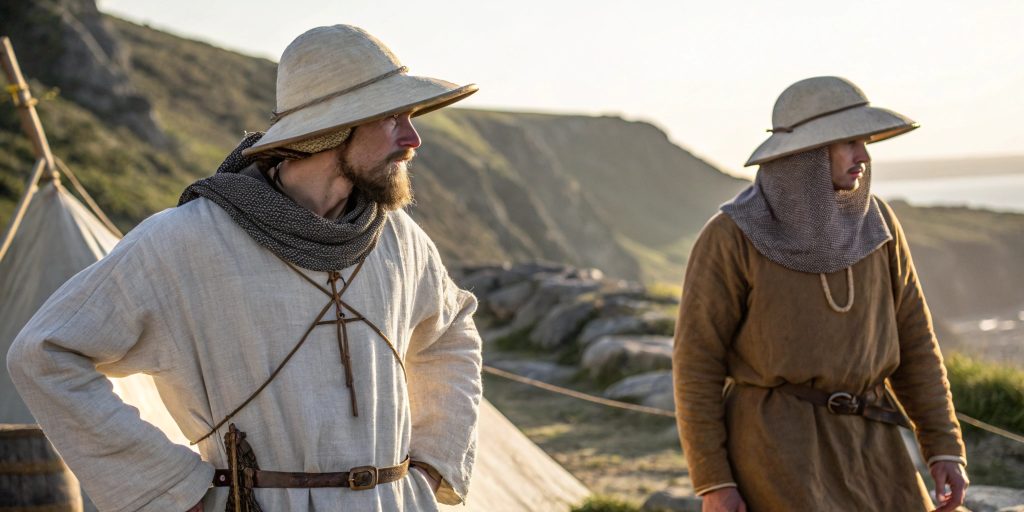Daily Life in the Viking Age, Vikings
Did Vikings Wear Sunscreen?
Modern society is learning about the dangers of UV radiation. This makes us wonder: did Vikings protect themselves from the sun? The idea of Viking sunscreen sparks curiosity about their skin care.
Due to their location, Vikings faced a lot of sun. Investigating their sun protection reveals exciting facts about their lifestyle. This section explores whether Vikings used sun protection, setting the stage for learning more about their skincare.
Introduction to Viking Sun Protection
The Vikings had to find ways to protect themselves from the sun. They lived in harsh environments and needed to shield their skin from UV rays. This need was common across many cultures, where people used creative ways to protect their skin.
The Viking lifestyle was tough, with lots of time spent outside. During voyages and farming, they faced dangers from the sun, so they used different ways to protect themselves from the sun.
Clothing made from natural materials was a key part of their sun protection. They also used mud or animal fats for extra protection. Archaeology shows that Vikings knew how to care for their skin, even in tough conditions.
Understanding UV Rays and Their Effects
Ultraviolet (UV) rays are electromagnetic radiation from the sun. They are divided into UVA and UVB. UVA rays go deep into the skin and cause early aging. UVB rays cause sunburn, making it important to apply sunscreen lotion.
When skin meets UV rays, it darkens melanin and protects itself, but sunscreen lotion can enhance this protection. However, too much exposure leads to sunburns, which are painful and can cause wrinkles and leathery skin if proper sunblock is not applied.
UV exposure is very harmful. It leads to 90% of nonmelanoma skin cancers. This shows how important sun protection is. Even the Vikings knew the dangers of too much sun.
Historical Context of Sunscreen Use
The history of sunscreen is filled with ancient sun protection methods, similar to how we now use modern lotion. Many cultures around the world found ways to protect themselves from the sun. This shows how people have always tried to overcome environmental challenges.
When was sunscreen invented? Modern sunscreen became common in the 20th century. But ancient Egyptians used aloe vera and rice bran to protect their skin, and Greek warriors applied olive oil as a natural sunblock to shield themselves from UV rays.
- Ancient Egyptians employed natural oils and pastes as sunblock for skin protection.
- Greeks: Olive oil is used as a sunblock during outdoor activities.
- Romans: Developed various oils and salves to mitigate sun exposure.
- Indigenous cultures: Employed local materials such as clay and plant extracts for sun protection.
The move from ancient sun protection to modern sunscreen is interesting. In the mid-20th century, commercial sunscreens started to appear. Brands like Coppertone and Neutrogena became well-known. These changes show how old practices turned into today’s sunscreens, designed to block the sun’s harm.
Viking Sunscreen: What Was It?
The Vikings had to find ways to protect their skin from the sun while engaging in various outdoor sports. They used natural ingredients to block UV rays, creating a primitive form of sunblock. This shows how they understood skincare and the environment.

Natural Ingredients Used for Protection
Vikings used natural things to shield their skin from the sun. They likely used:
- Animal fats that blocked UV rays.
- Plant oils that moisturized and protected a bit.
- Ochre which was a mineral that helped protect against the sun.
These items showed how Vikings used what they had to protect their skin. Even though we don’t know their SPF, they helped against UV damage.
Comparing Viking Practices to Modern Sunscreen
Viking sun protection and today’s sunscreens are different yet similar. Modern sunscreens have zinc oxide for broad protection, while Viking sunscreen uses natural ingredients without SPF ratings, relying on the cooling properties of their ingredients.
Today’s sunscreens are more advanced, offering better protection and hydration. But the main goal is still the same. The shift from natural to scientific products shows big progress in protecting skin from the sun.
Viking Lifestyle and Outdoor Exposure
The Viking environment was shaped by its unique geography and climate. They lived in Scandinavia and northern Europe, facing different weather, which influenced their outdoor activities.
This understanding helps us see the sun exposure risks they faced.
The Viking Environment: Geography and Climate
The Viking environment had coastal and inland areas with diverse landscapes. They adapted to fjords, forests, and more. The climate had long summers with lots of daylight.
This meant they were exposed to sunlight for a long time. They needed sun protection all year.
Daily Activities and Sun Exposure Risks
Viking daily activities included farming, fishing, and raiding. These tasks required them to be outside for hours, and both men and women faced high sun exposure risks.
This increased their chances of sunburn and skin problems. It shows how important sun protection was for them.
Viking Sunscreen: Myths and Facts
Looking into Viking sunscreen myths shows how complex sun protection was for Norse societies. Historical records give us a peek into how Vikings handled sun exposure. They used different methods, but these don’t match what many believe.
What Evidence Exists? Historical Accounts
Many historical accounts say Vikings knew they needed sun protection, especially on the sea. They used trees and shaded spots to stay out of the sun, enhancing their natural sunblock methods. Even though no sunscreen from their time has been found, they seemed to understand the harm of UV rays.
The Role of Clothing in Sun Protection
Viking clothes were vital in protecting them from the sun. They wore thick fabrics that blocked UV rays, and hoods and hats also helped keep their faces and necks safe from the sun.

These clothes show how Vikings thoughtfully made their textiles. They wanted to protect themselves from the sun, showing a smart part of their culture.
Modern Sunscreen Development
Sunscreen has changed a lot over time. We now know more about protecting our skin from UV rays. The first use of zinc oxide was a big step forward. It helps protect our skin from sun damage.
From the First Use of Zinc to Today’s Formulas
Zinc oxide was one of the first ingredients used in sunscreen. It protects against UVA and UVB rays. Sunscreen has come a long way since then. Now, there are many kinds of sunscreen for different skin types, including those that are more effective for sports.
Today, we have both chemical and mineral-based sunscreens. This shows how important it is to choose the right sunscreen. It helps keep our skin safe from the sun’s harmful rays.
Different Types of Sunscreens and Their Effectiveness
It’s important to know about the different sunscreens out there. There are mainly two types:
- Chemical Sunscreens: These absorb UV rays with chemicals like avobenzone. They are light and easy to put on.
- Mineral Sunscreens: These use zinc oxide and titanium dioxide. They sit on the skin’s surface and reflect UV rays, acting as a protective barrier like a cap. They are good for sensitive skin.
Not all sunscreens are the same. Broad-spectrum sunscreens are usually the best. When choosing sunscreen, look at the SPF, water resistance, and how often you must apply it to ensure excellent protection. The right sunscreen lotion protects your skin from the sun and prevents burns.
Conclusion
We’ve looked into Viking sunscreen and how ancient people protected themselves from the sun. The Vikings used natural things to protect their skin from the sun’s harm. This shows how sunscreen has changed over time.
Now, we have sunscreens that work against UV rays. They are made with science to keep our skin safe. This shows that protecting our skin is always important.
Thinking about the Vikings and today’s sun care reminds us of the need to protect our skin. We can use old wisdom or new products to keep our skin safe. Let’s take care of our skin as we go outside, knowing how to protect it.

